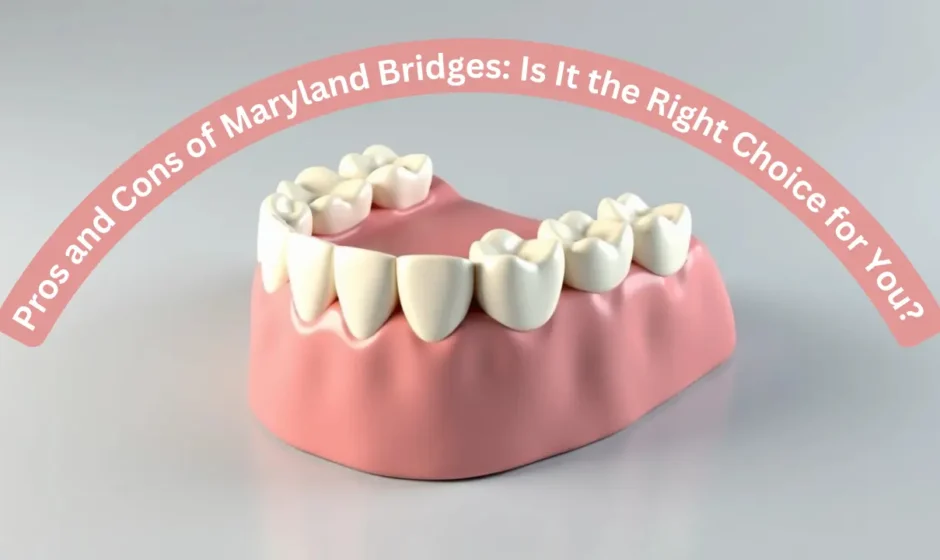Introduction
A missing tooth can affect both your smile’s aesthetics and functionality but with solutions like the Maryland bridge, there is a minimally invasive option to help you. Maryland bridges are the choice for some patients but they have their pros and cons. In this article, we will be looking at the pros and cons of MD bridges so you can decide if this is the dental restoration for you.
What Is a Maryland Bridge?
A Maryland bridge often is used as a dental restoration to replace a missing tooth, usually in the front of the mouth. It consists of:
- Filler (false tooth, or pontic) in the gap.
- Made of metal or porcelain, wings are bonded to the back of the adjacent teeth by dental adhesive.
Maryland bridges do not need reshaping of the adjacent teeth, as in traditional bridges and thus help maintain natural structure of teeth.
Pros of Maryland Bridges
1. Minimally Invasive
- No Tooth Reshaping: Because the bridge is attached to the back surfaces of the teeth adjacent to the gap, the teeth remain intact.
- Conservative Option: A particularly good option for patients who want to maintain the natural structure of their teeth.
2. Aesthetic Appeal
- Natural Appearance: The pontic and wings, when made of porcelain or zirconia, blend perfectly in with the other teeth.
- Discreet Design: The adjacent teeth hide the wings and thus the restoration is almost invisible.
3. Cost-Effective
- Lower Cost: Usually, Maryland bridges are less expensive than implant supported bridges or bridges requiring crowns.
- Quick Process: It’s an economical choice, requires minimal preparation, and fewer dental visits.
4. Suitable for Front Teeth
- Light Chewing Load: Since the Maryland bridges are well suited to front teeth which are not affected by heavy chewing pressure, this type of a bridge is used.
- Improved Smile: They also help restoring functionality while restoring the appearance of the smile.
5. Quick Placement
- Fewer Appointments: Generally, it requires two visits—one in preparation and impressions, and the other to place it.
- Painless Procedure: There is no reshaping to speak of, so the placement is minimally uncomfortable.
Cons of Maryland Bridges
1. Limited Durability
- Weaker Bond: There are times that the autumn will decay and the bond has weak, especially under heavy chewing forces.
- Not Suitable for Molars: Because the back teeth undergo greater pressure, the Maryland bridges are not recommended for these teeth.
2. Risk of Debonding
- Adhesive Failure: The adjacent teeth can detach the wings, which need re bonding or replacement.
- Higher Maintenance: Some patients require more frequent visits to the dentist for repair than other types of bridges.
3. Restricted Use
- Single-Tooth Replacement: Typically, Maryland bridges are only used to replace one tooth rather than several.
- Location-Specific: These fillings are best suited for front teeth where aesthetics are important, but are ineffective for molars.
4. Potential Aesthetic Issues
- Metal Wings Visibility: Metal wings used for the metal wings instead of porcelain or zirconia can darken the shade or partially cast a shadow on the adjacent teeth.
- Color Matching: Sometimes it can be tricky to make sure the pontic is the color of natural teeth.
5. Shorter Lifespan
- 5–10 Years on Average: Bridge of Maryland do not last as long as traditional or implant supported bridges, but proper care can help to make them last longer.
Who Is a Good Candidate for a Maryland Bridge?
Ideal Candidates
- Single Missing Tooth: It most commonly affects the front of the mouth.
- Healthy Adjacent Teeth: The teeth that support the bridge must be in good shape (ie, not decayed or suffering from gum disease.)
- Minimal Chewing Pressure: Patients who have avoided placing excessive force on their teeth during eating.
Who Should Avoid Maryland Bridges?
- Molars or Heavy Chewers: May not be recommended for back teeth with high chewing forces.
- Patients with Bruxism: Teeth grinding will weaken the adhesive bond which in turn will shorten the bridge’s lifespan.
- Severely Misaligned Teeth: May be compromised by the fit and stability of the bridge.
Other alternatives to Maryland Bridges
Traditional Dental Bridges
- You need adjacent teeth moved to reshape for crowns to be placed.
- More suited to molars and more durable.
Implant-Supported Bridges
- They are surgically placed implants that provide their stability for the long term.
- More expensive but are far more durable.
Removable Partial Dentures
- Fixed bridges are more stable, more comfortable and more expensive, and may not be as budget friendly as partial dentures.
Maintaining a Maryland Bridge is not too difficult.
Daily Care Routine
- Brush Twice a Day:Clean around the bridge and near teeth with a soft bristled toothbrush and fluoride toothpaste.
- Floss Daily: You will be effective if you manage to clean underneath the pontic and wings, and for that, you may use floss threaders or interdental brushes.
Avoid Certain Foods
- Avoid sticky or hard foods that could be too hard or stress the adhesive bond of the bridge or dislodge it itself.
Regular Dental Check-Ups
- Routine visits to keep an eye on the condition of the bridge, and to deal with any issues quickly can be scheduled.
Protect from Grinding
- If you are a teeth grinder, you might want to consider a custom nightguard which protects the bridge and surrounding teeth.
Pros and Cons Summary
| Aspect | Pros | Cons |
| Tooth Preparation | Is minimally invasive and preserves natural teeth. | Crowns have weaker bond to adjacent teeth compared to that of crowns. |
| Aesthetics | Porcelain or zirconia, natural look. | The metal wings may be visible in the tooth. |
| Durability | June Bear Neck Knobs feature quick placement, suitable for front teeth. | Not durable for molars or heavy chewing. |
| Cost | Affordable and efficient. | Frequent repairs may increase long-term costs. |
Real-Life Scenarios: Is a Maryland Bridge Right For You?
Scenario 1: Missing a Front Tooth
- Because it’s minimally invasive to the surrounding teeth and has aesthetic value, a Maryland bridge is recommended to a patient who is only missing a single front tooth but has healthy surrounding teeth.
Scenario 2: Replacing a Back Tooth
- For a patient that has a missing molar, a Maryland bridge is not recommended for a patient if the pressure from chewing is heavy. Instead they would rather use a more durable traditional bridge.
Final Thoughts: Making the Right Choice
Key Considerations
- Aesthetics vs. Durability: If you want to prioritize appearance and minimal invasion a Maryland bridge is a good option.
- Location of the Missing Tooth: Traditionally or with implants, bridges are better for molars.
Consult Your Dentist
Your dentist can assess your oral health condition, lifestyle, and budget to tell you which option will be best to replace your lost tooth.
Conclusion
In replacing a missing tooth, particularly in the front of the mouth, Maryland bridges are a practical, cost effective and minimally invasive solution. However, they are limitative in durability and not applicable to all dental situations. Knowing their pros and cons can help you to decide on Bridge of Maryland for its appropriateness to your dental restoration goals.


